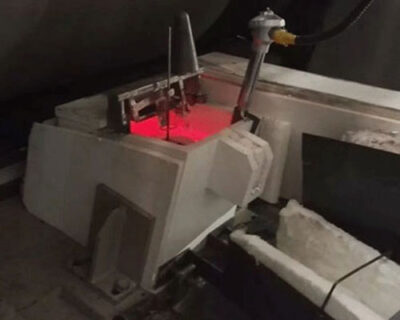Vertical slab refers to the process from the discharge of the static furnace to the casting and rolling of the slab. There are two commonly used vertical board methods. Dynamic dynamic vertical slab and static vertical slab.
The dynamic vertical slab method is often used for the inclined casting rolling. The operation process includes the following parts:
The operator enters the post according to the division of labor, starts the casting and rolling mill, and makes the rolls rotate at a high speed.
Check each discharge port, whether the discharge port that needs to be blocked in advance is blocked.
Check the temperature of molten aluminum in the standing furnace and degassing box. After the aluminum water temperature meets the requirements of the vertical plate, open the standing furnace flow eye, plug the lower sprue of the upper front box with a tap out cone/plug, discharge the front box of the hot launder, and detect the temperature of the melt in the front box. When the temperature is 20-40°C higher than the normal temperature, pull out the drill plug and start to supply flow to the mouth to run slag. When running slag, pay attention to adjusting the liquid level of the front tank, and it should not be too high to prevent aluminum leakage.
When running the slag, the main operator uses the pre-heated saw blade to pass through the nozzle cavity once to facilitate the smooth passage of the molten aluminum through the nozzle. Observe the running slag condition, and adjust the liquid level and host speed in time. The personnel on the exit side should promptly use a small spatula to clean up the aluminum alloy on the roller surface. Pay attention to the shovel to pull the slag out in the direction of the plate, use the roller cleaning device to clean the aluminum scraps on the roller surface, pay attention to the aluminum scraps to be cleaned thoroughly. Otherwise, aluminum shavings will scratch the feed nozzle, affect the surface quality of the cast-rolled sheet, and even cause the shutdown of the aluminum leakage. When the aluminum adhering to the lower roll is uniform and the nozzle cavity is not blocked, the speed will be reduced and the liquid level of the front tank will be adjusted at any time. After the roll, the lambda cooling water is passed through the roll and sprayed.
Clamp the board head with a pinch roller, and pay attention to make the board head pass the hydraulic scissors smoothly, cut off the irregular board head and then enter the coiling, and pay attention to the adjustment of the tension in the coiling.
Start the aluminum-titanium-boron-titanium wire feeding device and put in the aluminum-titanium-boron wire. First vent the graphite rotor and then slowly put it into the aluminum liquid to make it normal online degassing.
Adjust the front box temperature, casting and rolling speed, detect plate shape, plate thickness, and crystal grain, and adjust until the finished product is normal.

